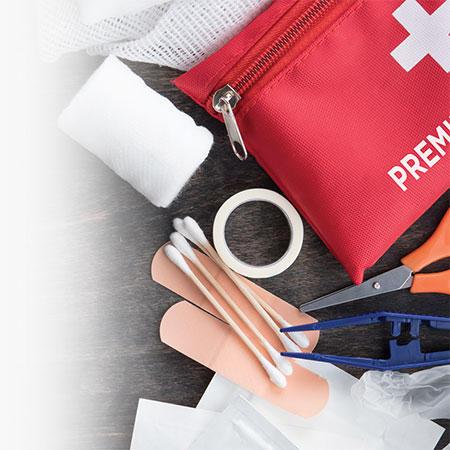Who is your best ally in the event of a minor health issue or wound? The first aid kit, of course!
Stocking your first aid kit to deal with the unexpected
Who hasn’t felt unprepared when faced with an incident affecting one’s health or that of a loved one? A simple cut, scrape or insect bite can turn into a mini drama if you don’t know how to react or if you don’t have the necessary first aid products.
Despite all possible precautions, we all face some misfortune at some point. It’s better to be prepared to take action by putting together or purchasing a first aid kit.
The following list of items is intended to be general in nature. You can adapt it to the context of use. You can also purchase a pre-assembled first aid kit.
| Examples of items to be included in your first aid kit | ||
|---|---|---|
| Hand sanitizer | Disposable antiseptic wipes | Medicated ointment for insect bite relief |
| Unscented gentle soap | Bottled water | Insect repellent |
| Sterilized saline water | Rehydration solution packets | Sunscreen with an SPF ≥ 30 |
| Antibiotic cream or ointment | Condoms | After-sun gel or lotion |
| Adhesive bandages (different shapes and sizes) | Small magnifying glass | Pain and fever medication |
| Butterfly stitches (adhesive strips) | Flashlight | Anti-inflammatory medication |
| Elastic bandage | Thermometer | Medication for nausea, vomiting and motion sickness |
| Sterile gauze | Scissors | Medication for diarrhea |
| Medical adhesive tape | Tweezers | Allergy medication |
| Alcohol swabs | Disposable sterile gloves | Lubricating eye drops |
It is important to include any medication in a first aid kit that may be necessary for a particular person based on their medical condition, for example:
- a rescue inhaler, for a person with asthma
- a nitroglycerin spray for a person with a heart condition
- an epinephrine auto-injector, for a person with a severe allergy
- glucose tablets, for a person with diabetes injecting insulin
- anti-anxiety medication for a person suffering from panic attacks
Storing a first aid kit
The place where you keep your first aid kit should be easily accessible and known to everyone. It can sometimes be beneficial to have more than one first aid kit so that you always have one on hand where unexpected incidents are most likely to occur: at home, the cottage, campground, office, etc.
It is generally not recommended to keep your first aid kit in your car or any other vehicle, as it may be exposed to significant temperature variations and humidity that can compromise the effectiveness of certain products, such as medication.
Monitor the contents of your first aid kit
For optimal use, you need to know what’s in your first aid kit. Make sure you know when and how to use each item it contains. It may be useful to make a list and summarize the instructions for use. Your pharmacist can help you make this list.
You should also check the contents of your first aid kit periodically, ideally, at least once a year (or at the beginning of each new season), to ensure that you have everything you need and that the products have not expired or been damaged. This will also refresh your memory. Let your loved ones know that the first aid kit exists and where it is located, and explain its contents and how to use them.
What not to forget
Here is some important advice:
- Return any medication that has expired or that has an altered appearance or smell to the pharmacy for safe disposal.
- The first aid kit is usually adequate for minor incidents. In the event of a more serious problem, such as choking, loss of consciousness, a serious burn or severe allergic reaction always contact emergency services immediately. Additionally, having taken first aid training will help you to react more efficiently under the circumstances.
- Make sure you have emergency numbers on hand, such as your medical clinic, pharmacy, and a poison control centre. Remember the two most important ones: 9-1-1 for all emergency situations and 8-1-1 to contact the Info-Santé healthline.
Don’t hesitate to speak to your pharmacist for information about first aid.

